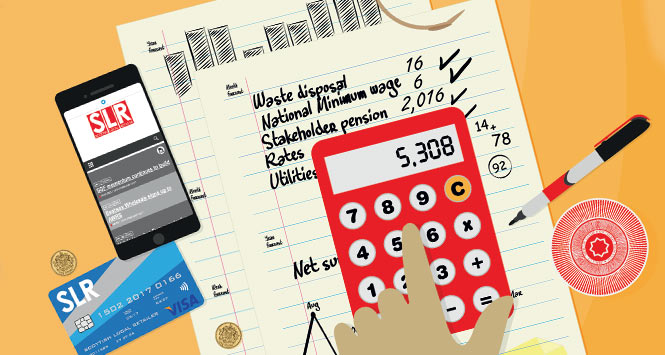With a perfect storm of constantly rising costs and constantly falling margins, more and more retailers are finding it increasingly difficult to maintain sustainable businesses – so what lies ahead for an industry that forms the very fabric of practically every community in Scotland?
by Simon Walton
With the current furore around business rates revaluations filling plenty of column inches and air time, the wider issue of the rising cost of business has once more risen to the top of the retail agenda in Scotland. The harsh reality for most local retailers in Scotland is that the huge increase in rates that many face is only the latest in a seemingly endless roll call of major cost increases: rates, national minimum wage, stakeholder pensions, waste, recycling removal. The list goes on. And all of this is in addition to constant downward pressure on pricing across a whole raft of product and service categories, which is inevitably squeezing already tight margins for retailers.
The big question, then, is what exactly is it that’s going to change to provide a glimmer of hope for an industry widely hailed as sitting at the very heart of the vast majority of Scottish communities? Westminster and Holyrood politicians are quick to recognise the value of retail to the wider economy, and to the social fabric of our communities – but are far less enthusiastic when it comes to actually providing a level playing field that gives local retailers a chance to build and maintain businesses that are viable in the longterm.
People and property
People and property are always going to be the most expensive overheads for convenience retailing businesses. New figures from independent researchers Retail Economics suggest that convenience retail is currently seeing rises in both these factors approaching 5%. With typical average margins in a small store running at below 20%, that’s a big increase in costs to absorb. In an economy where overall consumer price indices remain largely stagnant, businesses are significantly impacted by these rising costs.
Speaking in support of the Cost of Doing Business Report from the Money Advice Trust, Chief Executive Joanna Elson was concerned that what the Trust considers to be the heroes of our economy – small businesses – are under fire, something that represents a real threat to the wider economy.
“Whether it’s the local corner shop we pop into on the way home from work or an independent butchers, we all benefit from their success,” said Elson. “That success has a ripple effect across the UK as small businesses help to make other businesses tick by acting as contractors or putting money into the supply chain. They bring choice and opportunity to us all and it is essential that we nurture these businesses to ensure they continue to revive our economy. It is therefore vital that the Government, creditors, regulators and the free advice sector work together to contribute to our growth.”
Minimum wage
In principle, most retailers accept the social value of a minimum wage. What many find harder to deal with is the commercial reality of a continually increasing minimum wage. Simply increasing the minimum wage without understanding the commercial and social context is a very blunt tool to solve a very complex problem. This April’s 50p rise in the minimum hourly rate (to £7.20 for over 25s), for instance, is only likely to result in a potential further cut back in staff hours, and yet more personal hours devoted to working in the business, rather than developing it. Is that what the Government was hoping to achieve?
When he spoke to SLR in January, Scottish Grocers’ Federation President Dennis Williams said: “I’m all for giving someone a reasonable wage. I have no issue with that at all. The problem is, once again, the constraints placed on a small business with the overhead that represents. I know that staff hours are getting cut back, people are not getting replaced, and people who own businesses are needing to work longer hours.”
Dennis also highlighted the vital role that local retailing plays in offering versatile employment opportunities for young starters, part timers, and later-life workers, as well as providing full time careers, all within local communities. Williams says that by making it harder for employers to take on new people, current wage legislation is making business development in this sector difficult. “Owners are working even longer in their businesses, leaving less time to work on development and creating employment opportunities. That’s going to take out a lot of the dynamism of the sector and not be good for the local economy at all.”
Rates ruckus
The latest elephant in the room however is the rates revaluation. The link between rates and deemed property value, as opposed to business turnover, means that retailers can find themselves paying more, even in a declining business. With revaluations still underway, it’s still possible that overall business rates bills will run ahead of inflation, currently 1.6% on the Consumer Prices Index, as measured by the Office for National Statistics. David Burke, who is Director of Rating at JLL, the financial and professional services firm, said the detailed picture on business rates offered some good news, but only in that Scottish retailers are paying no more than elsewhere in the UK.
“The decision to match the ‘small’ multiplier in England at 46.6 pence in the pound ensures parity with small ratepayers south of the border and puts Scotland on a level playing field,” he said. “The Scottish Government should also be applauded for enhancing the Small Business Bonus Scheme which means that nearly 100,000 firms across Scotland will benefit from either reduced or zero business rates. At present all properties with a Rateable Value (RV) of more than £35,000 pay the ‘large’ multiplier which subsidises those businesses with a combined RV up to and including £18,000, and where below RV £10,000 no rates are paid, tapering to 25% relief at RV £18,000. From 1 April 2017 this lower threshold will be increased to RV £15,000 and all RVs below £51,000 will benefit from the reduced rate poundage.”
That’s of little comfort to small businesses who face huge hikes in their rates, however. SLR’s Woodlands Local store faces a very significant increase of £7,000 on its rateable value this year, and our business is not unusual.
Director of the Scottish Retail Consortium David Lonsdale said: “The Finance Secretary has at least acknowledged our concerns about business rates by keeping the poundage rate in line with the UK, and with his plans to alter the threshold of the Large Business Rates Supplement. However, 5,077 retail premises will continue to pay higher business rates than they would in comparable premises down south and many of those retailers are also set to begin forking out for the Apprenticeship Levy from April. These public policy costs are a significant burden to retailers and are difficult to absorb.”
Taxing issues
The cost of establishing and administrating the workplace pension scheme is another form of indirect taxation, while just over the horizon there’s another a huge change to taxation coming in the shape of the Inland Revenue’s ‘Making Tax Digital’ initiative. This will require a complete overhaul of the way businesses report liabilities and pay their dues, again incurring more financial and time costs. Although the exact details of the overhaul have yet to be finalised, Scottish accountants and business advisors Springfords advise retailers to begin preparing now in order to minimise costly disruption down the line. Corporate Tax Partner Jimmy Hair said: “With limited exceptions, small unincorporated businesses will, from April 2018, be compelled to keep digital records using HMRC-compatible software and apps and submit quarterly digital updates. VAT and corporation tax will be included from April 2019 and 2020 respectively.”
In their Cost of Doing Business report, the Money Advice Trust welcomed the impending abolition of the annual tax return, but had concerns over the extra workload that the Making Tax Digital initiative will put on retailers and business owners in general. “This will be a significant upheaval. It is vital that the Government manage this transition to real-time accounting, and that any penalties for missed deadlines are proportionate.”
The personal tax burden is also set to rise to its highest level since 1986, according to think tank the Institute for Fiscal Studies. Less money in the pockets of consumers means less money at the tillpoint.
Margin reductions
Lower and lower margins on many staple local retailing products and services as well as increased transaction charges and dwindling commissions are a constant reminder of the costs of doing business. Continually burdening small business with higher costs while margins and profits are falling is simply unsustainable.
The Scottish and UK Governments have routinely and enthusiastically lauded the local retailing sector for providing a unique service to our nation’s communities. The real issue here is whether they are prepared to put their money where their mouths are and create the conditions for this industry to flourish in the long term.





